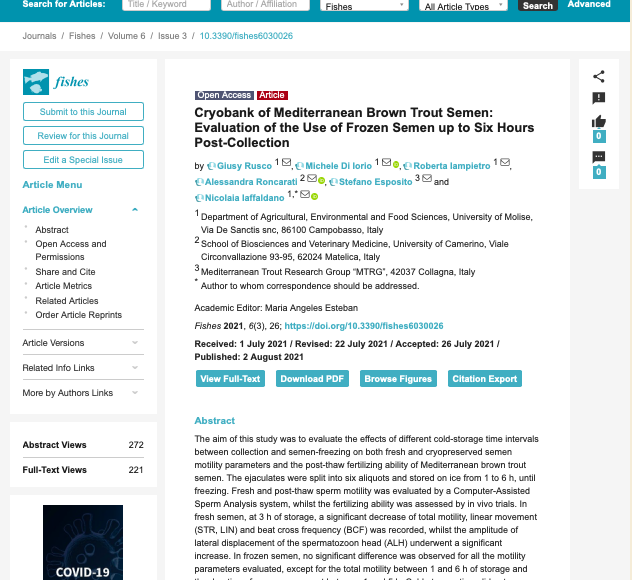The main objective of our project is to safeguard the native trout of Molise and the habitats they inhabit, but it is still important that the results obtained are shared with the scientific community through the publication of articles in international journals. This constant activity is essential so that the model we are applying in Molise waters can be taken as an example, tested and replicated not only in Italy, but also in the rest of Europe and the world.
On Fishes, the publication of the studies we are carrying out continues on the use of cryopreserved seed in the artificial reproduction of native trout. In this case, we monitored the quality of the frozen semen through different time intervals from the moment of collection on the river to the actual freezing in the University laboratories. We thus understood that, although some characteristics of the quality of the semen vary, in the first 6 hours from harvest to freezing, the semen (stored on ice) can be frozen and successfully used in subsequent artificial reproduction activities.
Scientific paper in MDPI – Fishes: Cryobank of Mediterranean Brown Trout Semen: Evaluation of the Use of Frozen Semen up to Six Hours Post-Collection
The aim of this study was to evaluate the effects of different cold-storage time intervals between collection and semen-freezing on both fresh and cryopreserved semen motility parameters and the post-thaw fertilizing ability of Mediterranean brown trout semen. The ejaculates were split into six aliquots and stored on ice from 1 to 6 h, until freezing. Fresh and post-thaw sperm motility was evaluated by a Computer-Assisted Sperm Analysis system, whilst the fertilizing ability was assessed by in vivo trials. In fresh semen, at 3 h of storage, a significant decrease of total motility, linear movement (STR, LIN) and beat cross frequency (BCF) was recorded, whilst the amplitude of lateral displacement of the spermatozoon head (ALH) underwent a significant increase. In frozen semen, no significant difference was observed for all the motility parameters evaluated, except for the total motility between 1 and 6 h of storage and the duration of sperm movement between 1 and 5 h. Cold-storage time did not significantly affect the percentage of live embryos following the use of frozen semen. In conclusion, our results showed that, if necessary, the Mediterranean brown trout semen can be frozen even until 6 h post-collection without losing its fertilizing ability.
Here the original paper.



